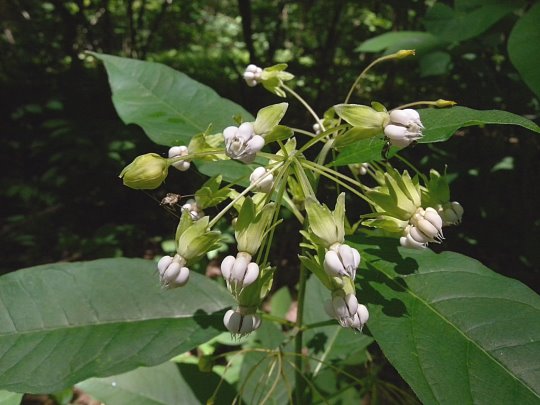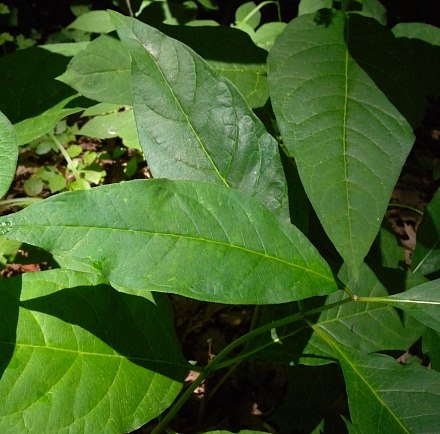
The stem terminates in one or more umbels of flowers spanning 2-4" across. The umbels are relatively open and the flowers droop somewhat from their pedicels. Each flower is about ¼" across and ½" long, consisting of 5 petals that hang downward, 5 curved cylindrical hoods that surround a central column, and the reproductive organs. The insignificant sepals are hidden by the petals. Each hood has an exerted horn. The flowers are bicolored: the petals are green or pale purple, while the hoods and column are white or light pink. The slender pedicels are 1-2" long, light green, and either glabrous or minutely short-pubescent. The blooming period occurs during the summer for about a month. Afterwards, fertile flowers are replaced by erect seedpods (follicles) that are up to 6" long and ¾" across; they are narrowly lanceoloid in shape. During the fall, each seedpod splits open along one side to release its seeds. The seeds have tufts of hair at their apices; they are distributed by the wind. The root system consists of a taproot.
Cultivation: The preference is partial or dappled sunlight, mesic conditions, and a rich loam or sandy loam with organic matter. The location should be protected from prevailing winds.
Range & Habitat: Poke Milkweed is widely distributed across Illinois, but it is relatively uncommon. Illinois lies along the western range limit of this species. Habitats consist of woodland openings, rich mesic woodlands, sandy woodlands, upland rocky woodlands, wooded slopes, areas along paths in woodlands, and woodland borders. Poke Milkweed is found in deciduous woodlands where oaks, maples, and similar trees are dominant.
Faunal Associations: The flowers of Poke Milkweed attract bumblebees and butterflies, including the Monarch and Great Spangle Fritillary butterflies. These insects suck nectar from the flowers. Other insects feed on the foliage, flower tissues, seedpods, pith of the stems, or plant juices. The following beetles have been found on Poke Milkweed: Chrysochus auratus (Dogbane Beetle) and Labidomera clivicollis (Swamp Milkweed Leaf Beetle). Other insects that feed on milkweeds (Asclepias spp.) include larvae of Tetraopes basalis (Milkweed Longhorn) and Tetraopes tetrophthalmus (Red Milkweed Beetle), larvae of Rhyssomatus lineaticollis (Milkweed Stem Weevil), Lygaeus kalmii (Small Milkweed Bug) and Oncopeltus fasciatus (Large Milkweed Bug), Aphis asclepiadis and other aphids, caterpillars of the moths Cycnia inopinatus (Unexpected Cycnia) and Cycnia tenera (Delicate Cycnia), and caterpillars of the butterfly Danaus plexippus (Monarch). Mammalian herbivores usually avoid consumption of milkweeds because their foliage contains toxic cardiac glycosides and it is bitter-tasting.
Photographic Location: Along a path in a sandy woodland at the Indiana Dunes State Park in NW Indiana.

Comments: This is a tall-growing milkweed with unusual bicolored flowers. In Illinois, only Swamp Milkweed (Asclepias incarnata) and Common Milkweed (Asclepias syriaca) are as tall and their flowers are usually more unicolored. In some areas of the United States, Poke Milkweed has been known to hybridize with Common Milkweed, producing plants with intermediate characteristics. So far, such hybrid plants have not been observed in Illinois. The common name, Poke Milkweed, refers to a junior synonym of this species, Asclepias phytolaccoides. This latter scientific name was no doubt inspired by the superficial resemblance of this milkweed's leaves to those of an unrelated species, Pokeweed (Phytolacca americana).